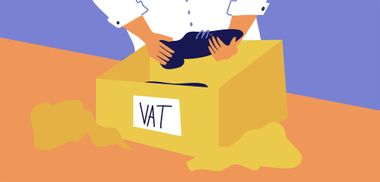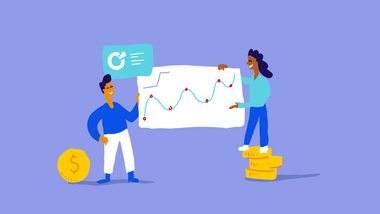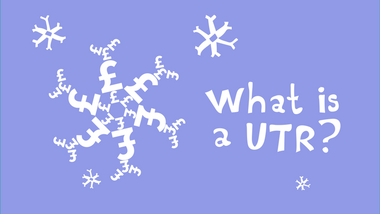What Is VAT for UK Amazon Sellers?
Once you’ve crossed an annual turnover of £90,000 within the last 12 months, you must register for VAT with HM Revenue and Customs (HMRC), but what’s next? Find out how much to charge and how to reclaim VAT.

Amazon is a popular online platform for most business owners and large retailers to sell their goods and services. Whether it’s providing business-to-business (B2B) or business-to-consumer (B2C) services, selling products and services online help most businesses to get additional revenues in this digital era.
But one of the topics that Amazon sellers face doubts about is Value Added Tax (VAT). Questions like- what is VAT? Should my business apply for VAT? How much should I charge? How does VAT work? And how should I go about claiming VAT?- are always at the back of their mind.
By the way, if you’re tired of dealing with accounting tasks that can get really complex for an e-commerce business, we’re here to help you sort your accounting documents for the e-commerce platform. Drop us a chat.
Skip to:
What Is VAT for UK Amazon Sellers?How Does VAT Work for Amazon Sellers?
What Are the Current VAT Rates?
Does My Company Need To Register for VAT?
What Documents Do I Need To Register for VAT?
I Have Registered for VAT. But How Do I Upload My Details on Amazon?
Amazon VAT Invoice and Receipt
What if I Am Selling My Products to a Non-UK Customer, Does VAT Still Apply?
Guide to Reclaiming VAT
What Are the Goods and Services Exempted From VAT?
How To Calculate VAT on Amazon Sales?
Summing Up: The Importance of VAT for Amazon Sellers
What Is VAT for UK Amazon Sellers?
VAT stands for Value Added Tax. It is also known as consumption tax and applies to businesses based in the European Union (EU) and UK zones.
The purpose of VAT is to add tax on top of the goods and services provided. This means that the goods and services that are bought and sold for use in the EU and UK have to be taxed. In other words, VAT (Value Added Tax) in the UK is also considered as an indirect tax where business owners collect tax on behalf of the government.
UK sellers on Amazon must be aware of all the latest rules to ensure they stay aligned to the country’s tax requirements. The new UK VAT rules 2021 have a few changes regarding VAT on imported goods and some slabs of low-value consignments. Most Amazon sellers must look to answer some key questions to ensure compliance. These are:
- What is my VAT rate in the UK?
- What is a VAT threshold?
- How do I register for VAT?
- How should I calculate my VAT and do my VAT accounting?
- What is a VAT return, and how to claim back my VAT?
- What are VAT penalties?
We answer these and many other such questions in this article.
Example of VAT
In the UK, all businesses with an annual turnover over the VAT limit of £90,000 must register for VAT and charge their customers a VAT percentage as per the rate slab their products or services fall under. The VAT collected from customers then needs to be passed on to the government after deducting the business’s own VAT outgoings (Input VAT).
Here is an example of how Value Added Tax is added at each stage of production and sale:
Jerry, who sells customised auto spares and décor items on Amazon, sources his pieces from a variety of manufacturers.
One of his manufacturers purchases raw material and pays VAT on the metal and other components to their supplier. The supplier sends the VAT percentage charged during this transaction to the government.
Once the manufacturer has made the item, they sell it to Jerry with a VAT component added as a percentage of the price. He then deducts the VAT (input tax) he paid to his supplier and sends the balance to the government.
Jerry retails the item with a VAT component to the end consumer. He keeps back the amount he has paid as VAT to his manufacturer and sends the rest to the government.
At each stage of sale, the VAT paid is on the value added at that stage. This ensures that neither the consumer nor the businesses involved in the transaction are overburdened with tax.
How Does VAT Work for Amazon Sellers?
VAT is charged on the price of a product at every stage, from manufacturing to selling to consumers. The worth of this product will increase and become more valuable at each stage.
For instance, a business owner has to pay for VAT when they purchase raw materials to make a handbag. After which, the business owner will charge VAT to their customers when they buy the handbag.
The VAT paid to suppliers is known as the input VAT, whereas the VAT received from the customers is called the VAT output tax. In the example given above, the input VAT would be what the business owner pays on raw materials. The output VAT would be what he/she charges on the finished handbag. Every VAT registered business must report output tax and input tax to HMRC through their VAT Returns.
Serene is an Amazon seller, and imports insulated lunch bags from another country. Before you she can sell it to the consumers in the UK, she will need to pay import tax to the tax authorities. After the payment has been made, she is then able to sell it. However, she will need to charge VAT on every sale that she makes. At the end of each period, you would have to add up all the VAT paid and collected and the difference is then either owed to or from HMRC.
What Are the Current VAT Rates?
According to the EU laws, the minimum percentage value of the standard VAT rate has to be set at least 15% and the reduced rate at 5%.
The current VAT rate in the UK is 20%. The charging of VAT rates depends on the goods and services supplied by the seller. Here is a list of current VAT rates and what it applies to in the UK:
| Description | Rates |
Standard Rate: All goods and services |
20% |
Reduced Rate: Health products, such as mobility aid; energy, and children’s car seats |
5% |
Zero Rate: Publications, children’s products, motorcycle helmets, or goods that are supply to non-EU countries |
0% |
This means that more than half of the goods and services sold on Amazon will have a 20% VAT charge on top of the sale price. Additionally, it is important that sellers know the current VAT rates in the UK to confirm that customers are being charged properly.
Does My Company Need To Register for VAT?
Here is a list of questions to ask yourself to check if your company needs to register for VAT.
Does your company hit the current VAT threshold?
Firstly, you will need to check the annual profits of your business. The current VAT threshold is £90,000. If your business has an annual turnover of £90,000 or within the last 12 months, you must register for VAT with HM Revenue and Customs (HMRC). But in the event your profit drops to less than £83,000 after the registration, you may deregister your VAT with HMRC.
Simon sells Bluetooth speakers on Amazon. His annual turnover in his first two years of business was £100,000. Since his business had reached the VAT threshold of £90,000, he decided to register for VAT. However, in his third year of business, he faces financial difficulties. When the financial year ends, he realises that his profit has dropped significantly to less than £80,000. With that, he decides to deregister his company’s VAT.
Are you selling zero-rated goods?
Secondly, check if you are selling zero-rated goods. This refers to products that cater to a wider population and benefit the less fortunate. For example, if you are selling children’s clothes or books, you will charge zero-rated VAT, which means 0% VAT. The goods are still VAT-taxable, but the rate of VAT you must charge your buyers is 0%. You still need to record them in your VAT accounts and report them on your VAT Return. If you are selling mainly these products or only these items, then you don’t have to register for VAT.
Here is a list of some of the products and services that fall under the zero-rate VAT slab:
- Sport, leisure, cultural activities
- Health such as services provided by doctors, hospitals, etc.
- Education such as services of a school or university
- Welfare and charities
- Power, utilities, energy and energy saving, heating
- Printing, postage, publications – books, magazines and newspapers
What Documents Do I Need To Register for VAT?
Here is a list of documents you will need to prepare when you register for VAT:
- National Insurance number – this is a unique reference no. for the taxpayer
- Certificate of incorporation
- Details of all associated businesses within the last two years
- Business bank account details
- Details of business that has been transferred or acquired, if appropriate
You may register online, or our accountants can help you with this if you want to focus on the growth of your company.
I Have Registered for VAT. But How Do I Upload My Details on Amazon?
After you registered for VAT, you will receive a VAT registration certificate. This includes:
- Your VAT number
- Submission deadline of your first VAT return and payment
- Your effective date of registration
The VAT number is a unique reference number that consists of 15 alphanumeric characters. The first two characters will be the country of the registered business. For instance, if your business is based in the U.K, it should be GB.
Whether you are a new or an existing seller, you must upload your VAT registration details on Amazon. You will also need to fill in your legal company name and registered address. With that, Amazon will require you to upload your VAT registration certificate for verification.
Amazon VAT Invoice and Receipt
Only VAT-registered businesses are allowed to issue Amazon VAT invoices. For VAT-exempted businesses, you will need to issue a VAT receipt. Attaching a VAT invoice and receipt with the goods sold is important as it keeps the customers informed about the rates being charged.
As of 1 July 2013, you are able to print and save a copy of your VAT invoice for every order you received on Amazon. The following details are to be included on the invoice:
- Company name & registered address
- VAT Registration Number
- Unique Identified Number
- Date of Issue
- Time of Supply
- Description of Goods or Services Supplied
- Total Amount (excluding VAT)
- Total Amount of VAT
- Price per item (excluding VAT)
- Rate of VAT charged per item
- Rate of any discount per item
It is also common that, at times, sellers may forget to attach the Amazon VAT invoice when they are busy fulfilling their orders. When customers request a VAT invoice for their purchases, sellers have to provide the document. This is so that customers may use the invoice to claim or for record purposes.
What if I Am Selling My Products to a Non-UK Customer, Does VAT Still Apply?
This is where things get complicated. If someone outside of the EU purchases goods from you, VAT does not apply to the customer. However, when goods are sold from a seller in the U.K to another customer who lives in another EU state, this will be considered as distance selling. Once the shipping of goods has exceeded the distance-selling threshold, the seller will have to register for the other EU state’s VAT and charge that rate to the customer.
Here is an example of distance selling:
Louis from France buys a batch of electric kettles that are listed on Amazon. The goods are dispatched from the warehouse in the UK and there will be a UK VAT charge. But once the goods have reached the French borders, it will have exceeded the distance-selling threshold. In this case, the company that sells electric kettles will have to register for France VAT and charge Louis accordingly.
To ease the shipment of goods abroad, some businesses store their stock in a fulfilment warehouse in other EU states. This is so that it will be shipped efficiently to the customers. But this will also mean that there is a higher chance of exceeding distance-selling threshold and businesses will have to register for EU VAT. You can do it on your own but if you need help, our accountants are experienced in helping e-commerce businesses deal with this.
The current distance-selling threshold in the UK is £70,000 per year. As the UK has left the European Union and the transition period of Brexit comes to an end on 31 December 2020, the threshold rates may change after that. We will let you know on our UK Osome blog as soon as we get the news.
Guide to Reclaiming VAT
The golden rule when reclaiming VAT back is that you can claim only on products and services that are used wholly and strictly for your business. This means office supplies, laptops and hardware, transport costs and services like accountancy all count if they are solely used for the purpose of your business. Other than that, here’s what you can and cannot reclaim for VAT.
| Can Reclaim VAT | Cannot Reclaim VAT |
Jamie owns a skincare company which is VAT-registered. She decides to buy a new laptop for her new staff. She goes to Amazon and purchases one. With the VAT invoice issued by the seller, she is able to claim the VAT. |
|
How do I claim VAT for my Business?
To claim VAT, you will need to submit an Amazon VAT refund/return form online to HMRC. Whether you are selling all goods and services or zero rate goods, you will need to keep a record of your sales. Refunds will be given within 10 days after your submission to HMRC. But it may take longer. You may contact HMRC if you do not hear from them after 30 days.
What Are the Goods and Services Exempted From VAT?
Some products and services are exempt from VAT. If all the goods and services you sell are excluded, your business is exempt, and you don’t have to register for VAT. On the flip side, this also means you cannot reclaim any VAT on your business purchases or costs.
You don’t have to register VAT if you are selling these:
- insurance, finance and credit
- education and training
- fundraising events by charities
- subscriptions to membership organisations
- selling, leasing and letting of commercial land and buildings - this exemption can be waived
How To Calculate VAT on Amazon Sales?
To claim your VAT, you will need to calculate the difference between your input tax and output tax. The difference in the amount is what you are owed or owe to the authorities.
So how does the calculation work? Let’s take a look at the example below:
Lionel buys a batch of power banks from his suppliers at £8 each. He sells the power bank at £10 each. As the goods are under the standard rate, he is going to charge £2 VAT on top of the selling price. So the calculation will be £8 - £2 = £6. The difference between output tax and input tax is £6. This amount is what Lionel owes to the tax authorities.
Summing Up: The Importance of VAT for Amazon Sellers
VAT gives sellers credibility
VAT can be a tedious task for many Amazon sellers. The process is time-consuming and complex, but the advantage of registering for VAT is that it gives the seller credibility. On the other hand, sellers can also gain monetarily when they reclaim their VAT.
Amazon as a platform has tried to make the process fairly seamless; once you enter your details, the Amazon vat invoices make the process pretty seamless.
File for VAT Returns, or face penalties...
With the demand for online shopping in this digital age, Amazon sellers should also take note of keeping a record of their sales and filing of VAT returns. According to HMRC Internal Compliance Handbook, failing to notify the government about VAT registration will result in penalties.
...or fines
Likewise, submitting false information will also result in hefty fines. Handling VAT for business requires a significant amount of administrative work. To ensure that your VAT claims are properly filed, you may engage an online UK accountant to take care of your VAT returns.







